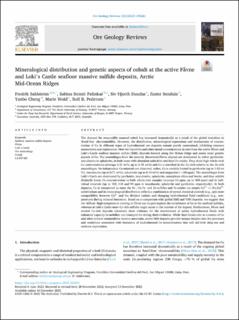| dc.description.abstract | The demand for responsibly sourced cobalt has increased dramatically as a result of the global transition to ‘fossil-free’ electromobility. However, the distribution, mineralogical expressions and mechanisms of concentration of Co in different types of hydrothermal ore deposits remain poorly constrained, inhibiting resource assessments and exploration. Here we report Co and other metal concentrations in ores from the active Fåvne and Loki’s Castle seafloor massive sulfide (SMS) deposits located along the Mohns Ridge and assess some genetic aspects of Co. The assemblages from the recently discovered Fåvne deposit are dominated by either pyrrhotite-isocubanite or sphalerite, in both cases with abundant anhydrite and local Fe-oxides. They show high whole-rock Co concentrations (average 0.31 wt.%, up to 0.98 wt.%) and Co is enriched in the Cu-rich relative to the Zn-rich assemblages. No independent Co-minerals are observed; rather, Co is variably hosted in pyrrhotite (up to 1.03 wt.%), isocubanite (up to 0.71 wt.%), sphalerite (up to 0.14 wt.%) and magnetite (∼100 ppm). The assemblages from Loki’s Castle are dominated by pyrrhotite, isocubanite, sphalerite, amorphous silica and barite, and they exhibit distinctly lower Co concentrations in both whole-rock samples (average 62 ppm, up to 368 ppm) and in individual minerals (up to 152, 148 and 99 ppm in isocubanite, sphalerite and pyrrhotite, respectively). At both deposits, Co is interpreted to enter the Fe-, Cu-Fe- and Zn-sulfides and Fe-oxides via simple Co²⁺ ↔ (Fe,Zn)²⁺ substitutions and its mineralogical distribution reflects a combination of crystal-chemical controls (e.g., spin state compatibility between Co²⁺ and the divalent cation) and changing hydrothermal fluid conditions (e.g., temperature) during mineral formation. Based on a comparison with global SMS and VMS deposits, we suggest that the ‘diffuse’ high-temperature venting at Fåvne can in part explain the enrichment of Co in the surficial sulfides, whereas at Loki’s Castle more Co-rich sulfides might occur in the interior of the deposit. Furthermore, Fåvne and several Co-rich deposits elsewhere show evidence for the involvement of saline hydrothermal fluids with enhanced capacity to mobilize and transport Co during their evolution. While their future role as a source of Co and other critical commodities remains uncertain, active SMS deposits provide unique insights into the processes and conditions associated with formation of hydrothermal Co mineralization that will aid both deep-sea and onshore exploration. | en_US |

